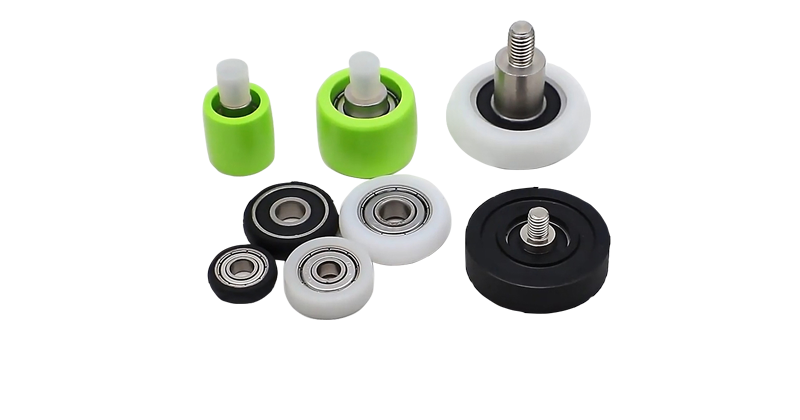86-15820855246(WhatsApp)
info@semeimachinery.com
 SEMEI Wheel Bearings : What are Plastic Roller Bearing?
SEMEI Wheel Bearings : What are Plastic Roller Bearing?Plastic roller bearings are a type of rolling element bearing that utilizes plastic materials for one or more of its components. They are designed to offer several advantages over traditional metal bearings, particularly in applications where weight reduction, corrosion resistance, and quiet operation are important factors.

Components:
Inner Ring: The rotating part that fits onto the shaft, which can be made of plastic.
Outer Ring: The stationary part that is mounted to the housing or a flat surface, which can also be made of plastic.
Rolling Elements: Cylindrical rollers that reduce friction between the inner and outer rings. These rollers can be made of plastic, ceramic, or sometimes metal.
Cage: Holds the rolling elements in position and maintains even spacing. The cage is often made of plastic.
Seals or Shields: Plastic bearings may include seals or shields to protect against contaminants and retain lubricant inside.

Materials:
Polyamide (Nylon): Commonly used for its excellent mechanical properties, wear resistance, and low coefficient of friction.
Polyoxymethylene (POM): Known for its high stiffness, hardness, and excellent sliding properties.
Polytetrafluoroethylene (PTFE): Offers exceptional chemical resistance and low friction.
Acetal Resins: Used for their dimensional stability and high strength-to-weight ratio.
Polyphenylene Sulfide (PPS): Known for its high temperature and chemical resistance.
Design Features:
Lightweight: Plastic materials are significantly lighter than metals, reducing the overall weight of the assembly.
Corrosion Resistance: Plastic does not corrode, making these bearings suitable for harsh environments.
Self-Lubricating: Some plastics have inherent lubricity, reducing the need for external lubrication.
Quiet Operation: Plastic bearings operate more quietly compared to metal bearings due to their softer nature.
Temperature Range: Certain plastics can perform well over a wide range of temperatures.
Chemical Resistance: Many plastics are resistant to chemicals, oils, and solvents, making them suitable for use in corrosive environments.
Advantages:
Weight Reduction: Plastic bearings are much lighter than their metal counterparts, which can be beneficial in applications where weight is a critical factor.
Corrosion Resistance: They do not rust or corrode, making them ideal for wet or corrosive environments.
Cost-Effective: Generally less expensive to manufacture than metal bearings.
Self-Lubricating: Many plastics have a low coefficient of friction and do not require external lubrication.
Quiet Operation: Plastic bearings operate with less noise and vibration.
Chemical Resistance: Suitable for use in environments where exposure to chemicals is common.
Disadvantages:
Lower Load Capacity: Generally, plastic bearings have lower load capacities compared to metal bearings.
Limited Temperature Range: While some plastics can withstand high temperatures, others have limitations and may deform at higher temperatures.
Wear and Tear: Over time, plastic components can wear more quickly than metal ones, especially under high-load conditions.
Applications:
Food Processing: Where hygiene and resistance to cleaning agents are important.
Marine Environments: Boats, ships, and other watercraft where corrosion resistance is critical.
Medical Devices: Surgical tools, diagnostic equipment, and implantable devices where lightweight and biocompatibility are required.
Automotive: Interior components, electrical systems, and other non-critical applications.
Consumer Goods: Household appliances, office equipment, and other consumer products.
Robotics: Lightweight components for robotic arms and other robotic systems.
Materials and Finishes:
Polyamide (PA): Good mechanical properties and wear resistance.
Polyoxymethylene (POM): High stiffness and dimensional stability.
Polytetrafluoroethylene (PTFE): Low friction and excellent chemical resistance.
Acetal Resins: Dimensional stability and high strength-to-weight ratio.
Polyphenylene Sulfide (PPS): High temperature and chemical resistance.
Lubrication:
Grease: Sometimes used, especially when the bearing is not self-lubricating.
Dry Lubricants: Graphite, molybdenum disulfide, and other dry lubricants can be embedded in the plastic material.
No Lubrication: Some plastics are inherently self-lubricating and do not require additional lubrication.
Installation and Maintenance:
Installation: Should be performed using appropriate tools and techniques to avoid damage.
Maintenance: Regular inspection and cleaning may be required, especially in harsh environments.
Conclusion:Plastic roller bearings offer unique advantages over traditional metal bearings, including lightweight construction, corrosion resistance, and quiet operation. They are ideal for applications where these characteristics are important, such as in food processing, marine environments, medical devices, and consumer goods.
This introduction covers the key aspects of plastic roller bearings, including their components, materials, design features, advantages, and typical applications. If you need more specific information or details about particular types or brands of plastic roller bearings, please let me know.
